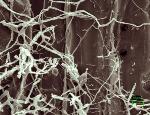| Postia placenta |
| The base of this hickory tree has been infected by Postia placenta, a fungus which causes brown rot in trees. The images shown here are of the reproductive stage of Postia placenta, which will produce spores. December. |
| The part of this fungus that "eats" the wood actually penatrates the wood to break down cellulose to consume the sugars (polysaccharides) it contains. Micrograph shows Postia placenta amongst wood cells. Image by Thomas Kuster, U.S. Department of Agriculture Forest Service, Forest Products Laboratory. |
| See Fungi Europaei, Polyporaceae s.l., E. Candusso (2005), p. 348. Listed as Oligoporus placentus, a former name. |
| This image shows the pore surface of Postia placenta growing on a log perpendicular to the ground. Note how pores also develop perpendicularly. The bumpy surface helps with spore dispersal; each bump acts like a cap, extending the pores outward. |
| The genome of Postia placenta has been decoded by an army of scientists: PDF FILE National Academy of Science |




